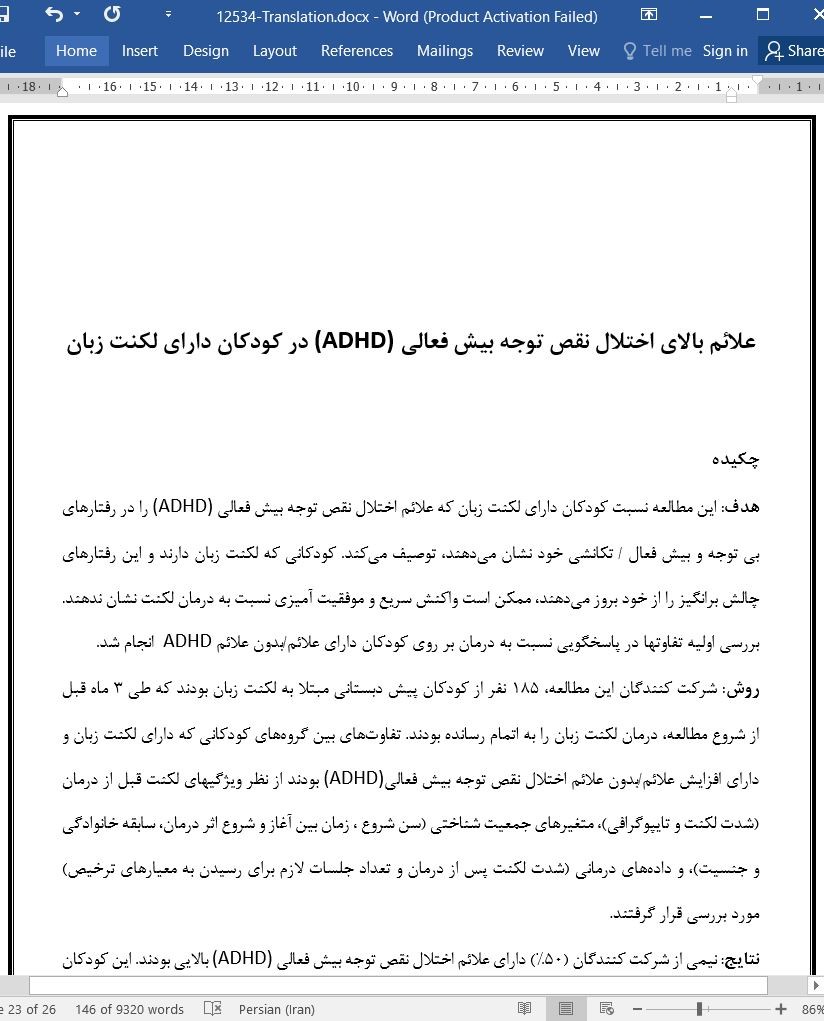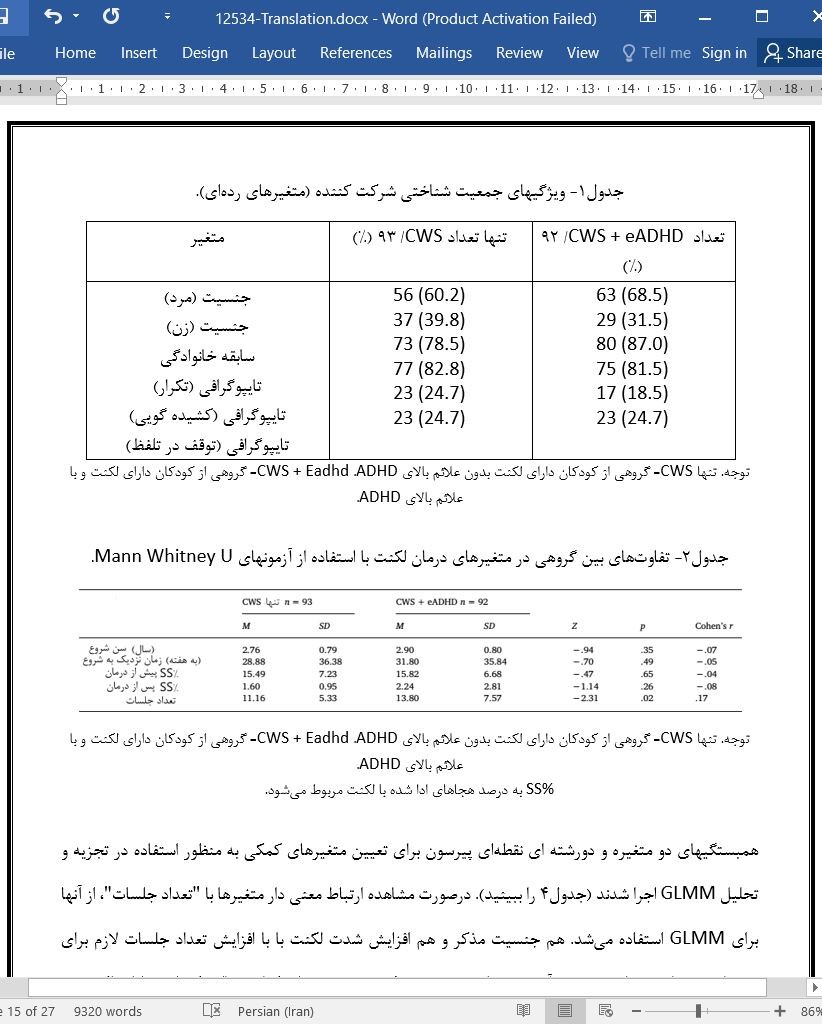
دانلود مقاله علائم بالای اختلال نقص توجه بیش فعالی (ADHD) در کودکان دارای لکنت زبان
چکیده
هدف: این مطالعه نسبت کودکان دارای لکنت زبان که علائم اختلال نقص توجه بیش فعالی (ADHD) را در رفتارهای بی توجه و بیش فعال / تکانشی خود نشان میدهند، توصیف میکند. کودکانی که لکنت زبان دارند و این رفتارهای چالش برانگیز را از خود بروز میدهند، ممکن است واکنش سریع و موفقیت آمیزی نسبت به درمان لکنت نشان ندهند. بررسی اولیه تفاوتها در پاسخگویی نسبت به درمان بر روی کودکان دارای علائم/بدون علائم ADHD انجام شد.
روش: شرکت کنندگان این مطالعه، 185 نفر از کودکان پیش دبستانی مبتلا به لکنت زبان بودند که طی 3 ماه قبل از شروع مطالعه، درمان لکنت زبان را به اتمام رسانده بودند. تفاوتهای بین گروههای کودکانی که دارای لکنت زبان و دارای افزایش علائم/بدون علائم اختلال نقص توجه بیش فعالی (ADHD)بودند از نظر ویژگیهای لکنت قبل از درمان (شدت لکنت و تایپوگرافی)، متغیرهای جمعیت شناختی (سن شروع ، زمان بین آغاز و شروع اثر درمان، سابقه خانوادگی و جنسیت)، و دادههای درمانی (شدت لکنت پس از درمان و تعداد جلسات لازم برای رسیدن به معیارهای ترخیص) مورد بررسی قرار گرفتند.
نتایج: نیمی از شرکت کنندگان (50%) دارای علائم اختلال نقص توجه بیش فعالی (ADHD) بالایی بودند. این کودکان در مقایسه با کودکان فاقد علائم ADHD بالا، برای دستیابی به نتایج موفقیت آمیز روانی گفتار به 25% زمان مداخله بالینی بیشتری نیاز داشتند. یافتهها نشان میدهند که علائم بالای ADHD ، افزایش شدت لکنت پیش از درمان و جنسیت مذکر با پاسخگویی ضعیفتری نسبت به درمان لکنت همراه بوده است.
نتیجه گیری: نسبت بالای کودکان دارای علائم بالای اختلال نقص توجه بیش فعالی (ADHD) ، و افزایش زمان تماس بالینی مورد نیاز در این زیر گروه برای دستیابی به نتایج موفقیت آمیز روانی گفتار، حاکی از نیاز به پزشکان برای انجام مداخلات لکنت زبان برای پرداختن به این چالشهای رفتاری همزمان است. این یافتهها از استفاده از راهکارهای دقیق مدیریت تعداد پروندههای کاری به منظور نشان دادن تفاوتهای فردی بین کودکان پشتیبانی میکند و اطلاعات مربوط به آثار آتی وپیش بینی مرض را که در دسترس والدین و پزشکان قرار دارد افزایش میدهد.
1. مقدمه
مدلهای چند بعدی معاصر لکنت اولیه، بر تعامل بین زبان، واج شناسی، فیزیولوژی، مزاج و رفتار در کودکان مستعد اختلال رشد عصبی لکنت تاکید دارند(Smith & Weber، 2016،2017). با توجه به اهمیت نوروپلاستی، مداخله اولیه در چنین مدلهایی از اهمیت ذاتی برخوردار است (Chang، Erickson، Ambrose، Hasegawa-Johnson، & Ludlow، 2008) و در نظر گرفتن عوامل فردی که ممکن است بر نتایج درمانی مؤثر باشد نیز حائز اهمیت است. در حالیکه مداخلات اولیه لکنت زبان، موفقیت آمیز گزارش شده است (De Sonneville-Koedoot، Stolk، Rietveld، & Franken، 2015؛ Guitar و همکاران، 2015؛ Millard، Nicholas، & Cook، 2008؛ Yaruss، Coleman، & Hammer، 2006)، نویسندگان هشدار میدهند که همه درمانها برای هر کودکی مؤثر نیست (Smith & Weber، 2016؛ Yaruss و همکاران، 2006). این مورد، به عنوان مثال در آزمایش بالینی کنترل شده تصادفی اخیر RESTART که کارآیی روشهای درمانی مستقیم و غیرمستقیم لکنت را مورد مقایسه قرار داد، صدق میکند (De Sonneville-Koedoot و همکاران، 2015). به طور متوسط 26٪ از کودکانی که تحت درمان قرار گرفتند ( 46 کودک از 176 کودک) در هر دو روش درمانی هنوز هم 18 ماه پس از درمان نیازمند درمان بودند و این نشان میداد که این اختلال هنوز به طور کامل درمان نشده است. نوع درمان (برای مثال، مستقیم یا غیر مستقیم) و همچنین تعامل بین نوع و زمان درمان، سن، شدت لکنت زبان و زمان نزدیک به شروع اثر درمان مورد بررسی قرار گرفتند و هیچ گونه شواهدی از نتایج درمان مشاهده نشد (De Sonneville-Koedoot و همکاران، 2015). این امر بر لزوم توجه به عوامل دیگر برای دستیابی به نتایج درمانی مثبت برای کودکانی که به درمان لکنت پاسخ نمیدهند، تأکید میکند.
5. نتیجه گیری
دادههای تجربی برای درک عینی اهمیت غلبه بر علائم بالای اختلال نقص توجه بیش فعالی (ADHD) در کودکان مبتلا به اختلال رشد لکنت اولیه، مورد نیاز است. این مطالعه وجود چالشهای همزمان خودتنظیمی را در تقریباً نیمی از پروندههای کودکان مبتلا به لکنت اولیه شناسایی کرد. علاوه براین، این مطالعه اثر منفی و معنی دار علائم بالای اختلال نقص توجه بیش فعالی (ADHD) را بر پاسخگویی نسبت به درمان لکنت بررسی کرده و بدین ترتیب از مطالعات آینده نگر که به درمان علائم بالای اختلال نقص توجه بیش فعالی (ADHD) و همچنین لکنت زبان کودکان میپردازند پشتیبانی میکند. در پایان، نتایج به دست آمده دستورالعملی را برای پروندههای آتی و مدیریت لیست انتظار، و بطور بالقوه اطلاعات بیشتری را در رابطه با آثار آتی و پیش بینی مرض برای والدین کودکان مبتلا به لکنت که در آینده به درمان آنها میپردازیم، فراهم میآورد.
Abstract
Purpose This study described the proportion of children who stutter who exhibit Attention Deficit Hyperactivity Disorder (ADHD) symptoms, manifesting in inattentive and hyperactive/impulsive behaviours. Children who stutter with these challenging behaviours may not respond as quickly and successfully to stuttering treatment. A preliminary exploration of differences in treatment responsiveness for children with and without ADHD symptoms was undertaken.
Method Participants were 185 preschool children who stutter who had completed stuttering therapy within 3 months prior to study commencement. Differences between groups of children who stutter with and without elevated ADHD symptoms were investigated, in terms of pre-treatment stuttering features (stuttering severity and typography), demographic variables (age at onset, time between onset and commencement of therapy, family history and sex) and treatment data (post-treatment stuttering severity and number of sessions to achieve discharge criteria).
Results One-half (50%) of participants exhibited elevated ADHD symptoms. These children required 25% more clinical intervention time to achieve successful fluency outcomes than children without elevated ADHD symptoms. Findings suggest that more ADHD symptoms, increased pre-treatment stuttering severity, and male sex were associated with poorer responsiveness to stuttering treatment.
Conclusion The large proportion of children exhibiting elevated ADHD symptoms, and the increase in clinical contact time required in this subgroup to achieve successful fluency outcomes, is suggestive of the need for clinicians to tailor stuttering intervention to address these concomitant behaviour challenges. Findings support the use of careful caseload management strategies to account for individual differences between children, and strengthen prognostic information available to parents and clinicians.
1. Introduction
Contemporary multidimensional models of early stuttering highlight interactions between language, phonology, physiology, temperament and behaviour in children predisposed to the neurodevelopmental disorder of stuttering (Smith & Weber, 2016, 2017). Inherent in such models is the importance of early intervention given the importance of neuroplasticity (Chang, Erickson, Ambrose, Hasegawa-Johnson, & Ludlow, 2008), and the importance of considering individual factors that may affect treatment outcomes. While successful early stuttering interventions have been reported (De Sonneville-Koedoot, Stolk, Rietveld, & Franken, 2015; Guitar et al., 2015; Millard, Nicholas, & Cook, 2008; Yaruss, Coleman, & Hammer, 2006), authors caution that not all therapies work for every child (Smith & Weber, 2016; Yaruss et al., 2006). This was the case, for example, in the recent RESTART randomised controlled clinical trial comparing the efficacy of direct and indirect stuttering therapies (De Sonneville-Koedoot et al., 2015). An average of 26% of children who received treatment (46 out of the 176) across both therapy approaches still required therapy at 18 months post treatment, indicating that the disorder had not yet been fully remediated. Type of treatment (i.e., direct or indirect), as well as interactions between treatment type and time in therapy, age, stuttering severity and time close to onset, were examined and found not to be predictive of treatment outcomes (De Sonneville-Koedoot et al., 2015). This underscores the need to consider additional factors to achieve positive treatment outcomes for children who do not respond to stuttering therapy.
5. Conclusion
Empirical data is required to objectively capture the important prevalence of elevated ADHD symptoms in children with early developmental stuttering disorders. This study identified approximately half of the children in early stuttering caseloads as presenting with concomitant self-regulation challenges. Furthermore, this study explored the significant negative effect of elevated ADHD symptoms on stuttering treatment responsiveness and thus provides support for future prospective studies of treatments that address elevated ADHD symptomology as well as the child’s stuttering. Finally, results yielded provide direction for future caseload and waitlist management, and potentially more informed individual prognostic information for parents of children who stutter who we treat in the future.
Sex (male)
Sex (female)
Family history
Typography (repetitions)
Typography (prolongations)
Typography (blocks)
Age at onset (years)
Time close to onset (weeks)
Pre-treatment %SS
Post-treatment %SS
Number of sessions
چکیده
1. مقدمه
1.1. خلق و خو و خودتنظیمی در کودکان مبتلا به لکنت
1.2. خودتنظیمی و اختلال نقص توجه بیش فعالی (ADHD)
1.3. مطالعه حاضر
2. روشها
2.1. شرکت کنندگان
2.2. معیارها
2.3. روند کار
2.4. تجزیه و تحلیل دادهها
3. نتایج
4. بحث
4.1. نقاط قوت و محدودیتها
5. نتیجه گیری
منابع
ABSTRACT
1. Introduction
1.1. Temperament and self-regulation in children who stutter
1.2. Self-regulation and attention deficit hyperactive disorder (ADHD)
1.3. The present study
2. Methods
2.1. Participants
2.2. Measures
2.3. Procedure
2.4. Data analysis
3. Results
4. Discussion
4.1. Strengths and limitations
5. Conclusion
References
- اصل مقاله انگلیسی با فرمت ورد (word) با قابلیت ویرایش
- ترجمه فارسی مقاله با فرمت ورد (word) با قابلیت ویرایش، بدون آرم سایت ای ترجمه
- ترجمه فارسی مقاله با فرمت pdf، بدون آرم سایت ای ترجمه



